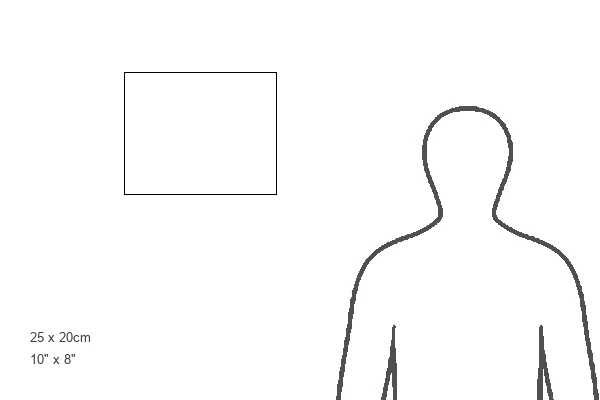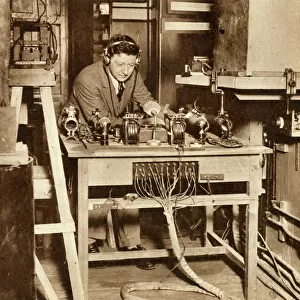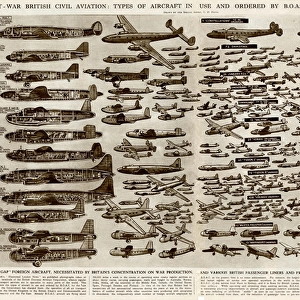Photographic Print : Splitting of the Atom - apparatus used by Dr J D Cockcroft
![]()

Photo Prints from Mary Evans Picture Library
Splitting of the Atom - apparatus used by Dr J D Cockcroft
Dr John D Cockcroft listening for sounds indicating atomic disintegration brought about by the bombardment with high-velocity protons of the lithium nucleus, which appears to break up into two helium nuclei. Physicists Cockcroft and E Ts Walton developed the Cockcroft-Walton accelerator to artificially accelerate atomic particles to high energies, to enable them to observe the results of splitting the atom. At the Cavendish Laboratory, Cambridge.
1932
Mary Evans Picture Library makes available wonderful images created for people to enjoy over the centuries
Media ID 14266434
© Illustrated London News Ltd/Mary Evans
1932 Adjusting Adjusts Apparatus Atom Atomic Breakthrough Cambridge Cavendish Department Electricity Experiment Headphones Laboratory Listening Listens Machinery Nuclear Particles Physicist Pump Scientist Sounds Split Splits Splitting Vacuum Accelerator Disintegration High Voltage
10"x8" (25x20cm) Photo Print
Discover the fascinating world of nuclear physics with our exclusive Media Storehouse Photographic Print of "Splitting of the Atom - Apparatus used by Dr J D Cockcroft" by Illustrated London News Ltd/Mary Evans from Mary Evans Prints Online. This captivating image showcases the groundbreaking experiment conducted by Dr John Cockcroft, where he listened intently for sounds indicating atomic disintegration caused by bombardment with high-velocity protons of a lithium nucleus. A must-have for any science enthusiast or history buff, this print offers a unique glimpse into the past and the remarkable advancements in scientific research. Bring home a piece of scientific history and ignite curiosity with this stunning photographic print.
Ideal for framing, Australian made Photo Prints are produced on high-quality 270 gsm lustre photo paper which has a subtle shimmer adding a touch of elegance, designed to enhance their visual appeal.
Our Photo Prints are in a large range of sizes and are printed on Archival Quality Paper for excellent colour reproduction and longevity. They are ideal for framing (our Framed Prints use these) at a reasonable cost. Alternatives include cheaper Poster Prints and higher quality Fine Art Paper, the choice of which is largely dependant on your budget.
Estimated Product Size is 25.4cm x 20.3cm (10" x 8")
These are individually made so all sizes are approximate
Artwork printed orientated as per the preview above, with landscape (horizontal) orientation to match the source image.
EDITORS COMMENTS
This evocative image captures the pivotal moment in the history of nuclear physics, as Dr. John Douglas Cockcroft (1897-1967) listens intently for signs of atomic disintegration at the Cavendish Laboratory in Cambridge, England, during the early 1930s. In this groundbreaking experiment, Cockcroft and his colleague Ernest Thomas Sinton Walton (1903-1995) employed their newly-developed Cockcroft-Walton accelerator to artificially accelerate atomic particles to unprecedented energies. By bombarding a lithium nucleus with high-velocity protons, they aimed to observe the results of splitting the atom. The apparatus in the foreground of the photograph reveals the intricacies of their machinery. The vacuum creating pump sits at the bottom left, ensuring a vacuum environment for the experiment. Cockcroft, wearing a lab coat and adjusting a knob, focuses intently on the sounds emanating from the experiment, listening for the distinctive indicators of atomic disintegration. He wears headphones to amplify the faint sounds, while the high-voltage electrical equipment hums in the background. The successful splitting of the atom, achieved in 1932, marked a significant breakthrough in the understanding of nuclear physics. This experiment paved the way for further research into the structure of the atom and the development of nuclear energy. The Cockcroft-Walton accelerator, a testament to the ingenuity and perseverance of these pioneering scientists, opened new doors to the exploration of the subatomic world.
MADE IN AUSTRALIA
Safe Shipping with 30 Day Money Back Guarantee
FREE PERSONALISATION*
We are proud to offer a range of customisation features including Personalised Captions, Color Filters and Picture Zoom Tools
SECURE PAYMENTS
We happily accept a wide range of payment options so you can pay for the things you need in the way that is most convenient for you
* Options may vary by product and licensing agreement. Zoomed Pictures can be adjusted in the Cart.






